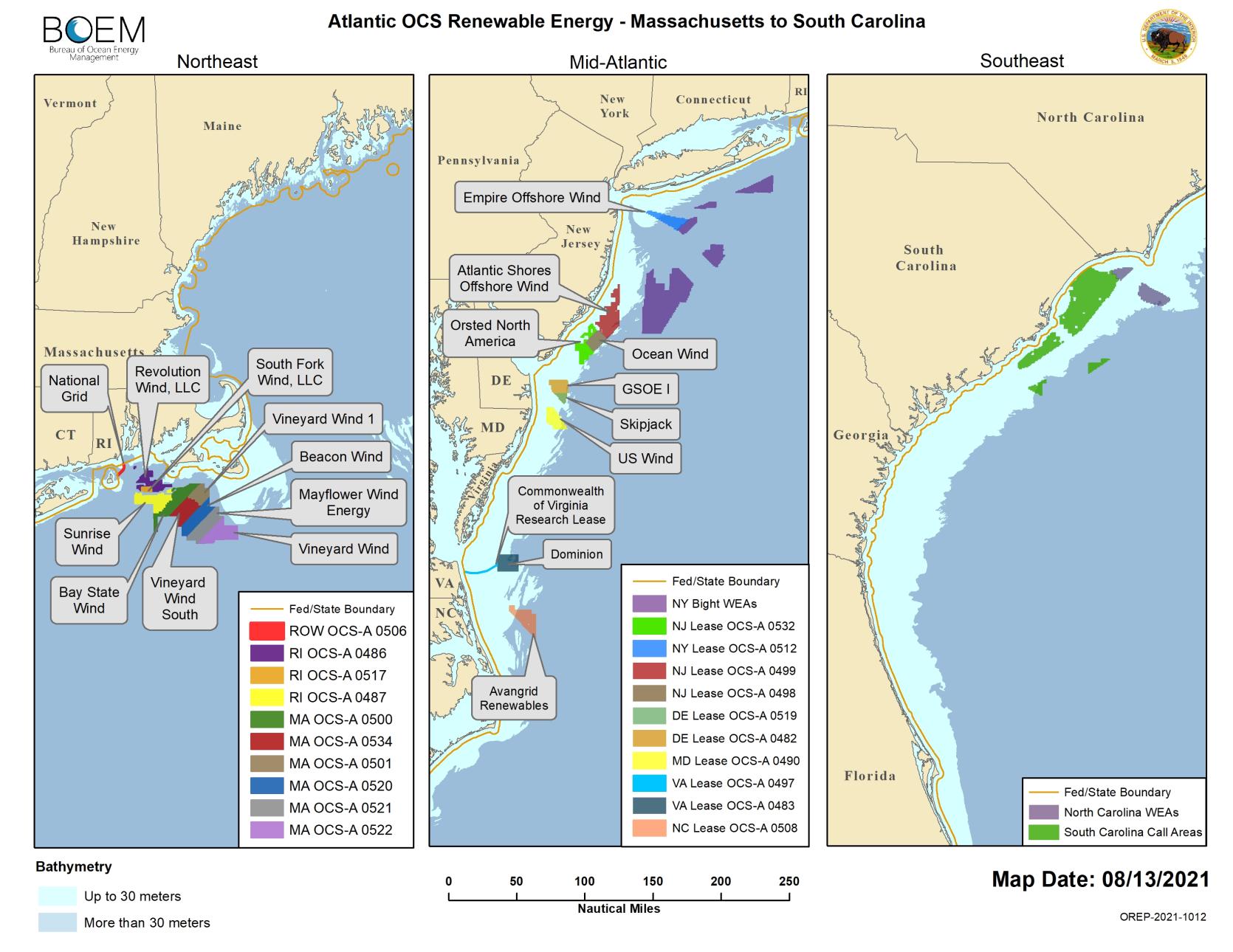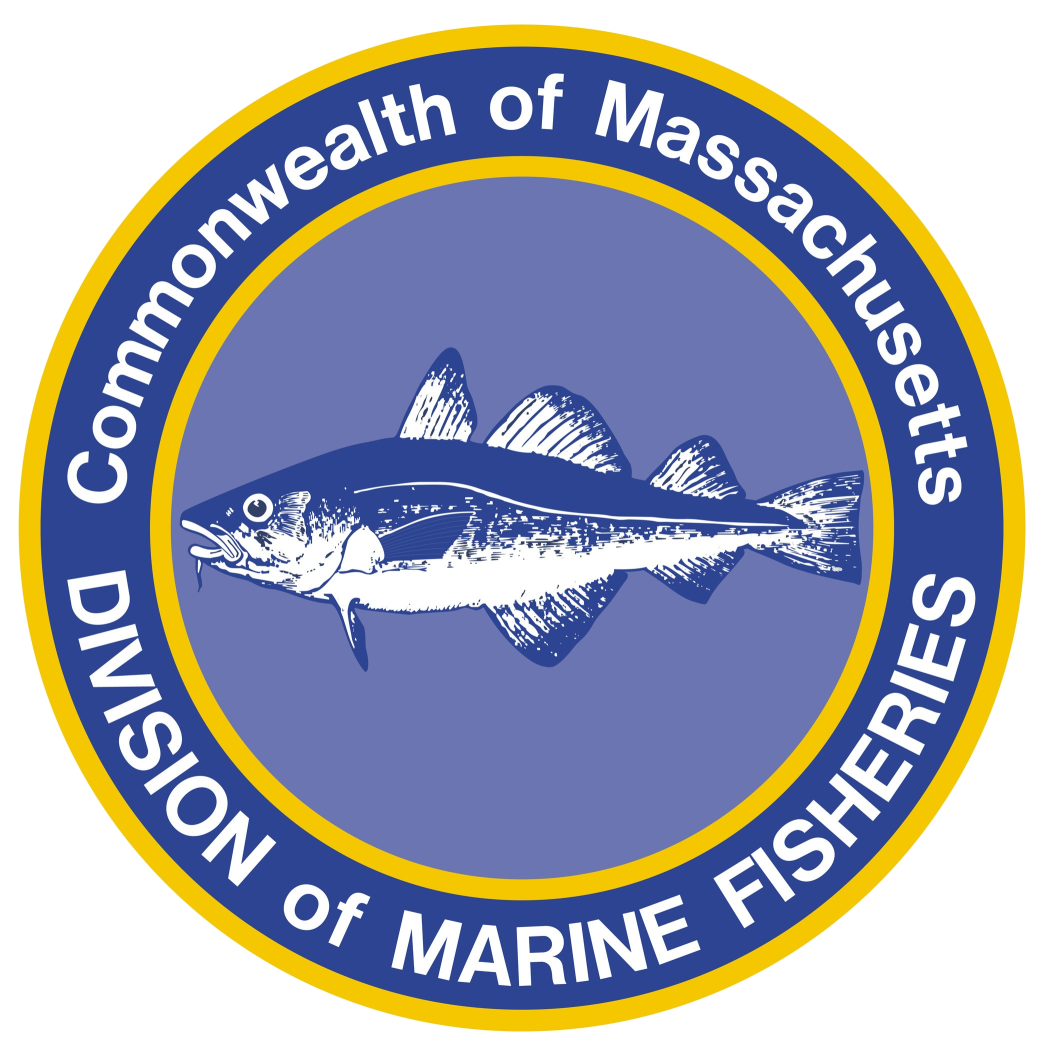- Division of Marine Fisheries

The offshore wind industry has seen an explosion in activity since MA DMF’s first industry update published in 2018. Global offshore wind energy capacity surpassed 27 gigawatts (GW) in early 2020. In March 2021, the Biden-Harris administration announced a national goal of generating 30 GW of offshore wind energy by 2030, marking the nation’s first federal-scale offshore wind energy goal. To achieve this goal, the Bureau of Ocean Energy Management (BOEM)—the agency tasked with regulating energy development in federal waters—intends to evaluate at least 16 Construction and Operation Plans (COPs) by 2025. In October 2021, Secretary of the Interior Deb Haaland announced plans to hold up to seven new offshore wind lease sales by 2025 in the Gulf of Maine, New York Bight, Central Atlantic, Gulf of Mexico, and offshore of the Carolinas, California, and Oregon.
Closer to home, Massachusetts intends to solicit proposals to contract for 5,600 megawatts (MW) of offshore wind power by 2027, a goal that has substantially increased from the 1,600-MW target announced in the 2016 Act to Promote Energy Diversity. To build the Commonwealth’s capacity for offshore wind development, the Massachusetts Clean Energy Center (MassCEC) has invested tens of millions of dollars into workforce training, research, and supply chain evolution (e.g., development of an industry directory to support business-to-business networking). Port infrastructure is also rapidly developing to meet industry needs. The New Bedford Marine Commerce terminal was the first multi-purpose facility in North America designed to support the construction, assembly, and deployment of offshore wind projects, and Salem Harbor is soon to follow. In December, Vineyard Wind, a joint venture between Avangrid Renewables and Copenhagen Infrastructure Partners (CIP), announced an agreement with the City of Salem and Crowley Maritime Corporate to develop Salem Harbor as the nation’s second major offshore wind marshalling port, which will allow for concurrent project construction in the Massachusetts Wind Energy Area (WEA).
BOEM’s process of authorizing offshore wind development occurs in four distinct phases: planning and analysis, leasing, site assessment, and construction and operations. In the Massachusetts WEA and the Massachusetts-Rhode Island WEA, projects are primarily in site assessment and construction stages. Site assessment requires BOEM approval of a Site Assessment Plan (SAP) outlining details related to meteorological and oceanographic surveys in a lease area. Following completion of site assessment surveys, a developer submits a COP outlining a plan for the proposed construction and operation of all on- and offshore facilities associated with the project. The COP analyzes environmental, cultural, and socioeconomic impacts resulting from the project to inform BOEM’s preparation of an Environmental Impact Statement (EIS) under the National Environmental Policy Act.
Here’s a quick overview of offshore wind activities by region:
Maine: Under the nation’s wind leasing strategy for 2021–2025, BOEM intends to hold a commercial lease sale within the Gulf of Maine in 2024. To initiate this process, BOEM hosted the Gulf of Maine Intergovernmental Renewable Energy Task Force Meeting on May 19, 2022. The Task Force is comprised of federal officials and elected Tribal, state, and local officials from Maine, New Hampshire, and Massachusetts. Topics included an overview of the commercial planning process for the Gulf of Maine and a framework approach for developing a Request for Interest (RFI). In October 2021, the State of Maine submitted an unsolicited research lease application to construct an offshore wind energy array (“Research Array”).
The array would include up to 12 floating wind turbine generators (WTGs) within a 10,000-acre lease area approximately 25 nautical miles offshore. It would be the nation’s first offshore floating wind research array.
Massachusetts and Massachusetts-Rhode Island WEAs: Vineyard Wind 1 (VW1) was the first commercial-scale offshore wind farm to be fully approved for construction in U.S. federal waters. The Project’s COP received approval on July 15, 2021. VW1 will consist of 62 turbines and an export cable that will travel through Muskeget Channel and Nantucket Sound to interconnect onshore at Covell’s Beach, Barnstable. Export cable construction is scheduled to begin this year and the project is expected to be operational by 2023.
On the heels of VW1, South Fork Wind was approved on November 1, 2021. Smaller in scale, the Project will consist of 12 turbines and an export cable that will interconnect at East Hampton, New York. Onshore construction has already begun, and the project is expected to be operational by 2023.
In 2021, BOEM submitted four NOIs to prepare EISs for the following projects: Revolution Wind, New England Wind, Sunrise Wind, and Mayflower Wind. The projects are in varying stages of permitting at the state level and environmental surveys are ongoing. Two additional projects in the MA WEA, Beacon Wind and Bay State Wind, received SAP approval for site characterization in June 2017 and September 2021, respectively. Neither project has submitted a COP.
New York Bight: In February 2022, BOEM held a record-breaking offshore wind auction for six lease areas in the New York Bight. The sale drew competitive winning bids from six companies totaling $4.37 billion, marking the highest-grossing competitive offshore energy lease sale in history, including oil and gas industries. The new lease areas expand on a growing industry offshore of New York and New Jersey. In 2021, BOEM submitted three NOIs to prepare EISs for the following projects: Ocean Wind, Empire Wind, and Atlantic Shores.
Central Atlantic: Planning, analysis, and leasing activities continue farther down the Atlantic coast. In 2021, BOEM submitted two NOIs to prepare EISs for the Coastal Virginia Offshore Wind Commercial Project and the Kitty Hawk Offshore Wind Project. In April 2022, BOEM announced that it will publish a Call for Information and Nominations (Call) to assess commercial interest in wind energy leasing activities farther offshore in the Central Atlantic. The six Call Areas (A-F) comprise approximately 3.9 million acres offshore of Delaware, Maryland, Virginia, and North Carolina. Lastly, the environmental assessment of the Carolina Long Bay area offshore of North and South Carolina is complete and wind energy developers will bid for one or both lease areas in the Wilmington East WEA in May 2022.
Gulf of Mexico and the Pacific Coast: As the nation marches toward its goal of 30 GW by 2030, offshore wind will continue to develop in the Gulf of Mexico and along the Pacific Coast. BOEM held its second Gulf of Mexico Intergovernmental Renewable Energy Task Force meeting in February 2022. In April, the agency announced it will publish a Call to assess commercial interest off the coast of Oregon. In the same month, BOEM published a Draft Environmental Assessment for the Morro Bay Wind Energy Area in southern California, and in May BOEM announced a Finding of No Significant Impact (FONSI) for the Humboldt Wind Energy Area in northern California.
Key Issues for MA’s Fisheries:
The Commonwealth supports the co-existence of wind energy development and the fishing community. To ensure the two industries are compatible, state and federal agencies are working together with regional bodies on issues including regional monitoring and fisheries compensation.
Regional science: Several organizations have emerged in recent years to facilitate offshore wind research and monitoring at a regional scale:
- The Responsible Offshore Development Alliance (RODA) collaborates with regulatory agencies, developers, and researchers to coordinate science and policy approaches to managing offshore development with a focus on minimizing conflicts with the fishing community. Current efforts include the creation of a Fisheries Knowledge Trust, an industry-owned platform to facilitate information sharing between the fishing and science communities.
- The Responsible Offshore Science Alliance (ROSA) seeks to advance regional research and monitoring of fisheries and offshore wind interactions from Maine to North Carolina. ROSA’s interim Offshore Wind Project Monitoring Framework and Guidelines were published in March 2021 to identify key elements of offshore wind fisheries’ project monitoring plans and associated studies.
- The Regional Wildlife Science Collaborative (RWSC) is hosted by the Northeast Regional Ocean Council (NROC), Mid-Atlantic Regional Council on the Ocean (MARCO), and the Coastal States Stewardship Foundation (CSSF) to support research and monitoring of interactions between wildlife and offshore wind. Current efforts include creation of an Offshore Wind & Wildlife Research Database to track efforts focused on marine mammals, sea turtles, birds and bats, protected fish species, habitat and ecosystem, and cross-taxa surveys.
Fisheries compensation: BOEM is working with NOAA Fisheries and affected coastal states, including Massachusetts, to develop guidance for mitigating the impacts of offshore renewable energy projects. As part of this effort, BOEM published a Request for information in November 2021 to obtain public input on avoiding, minimizing, and compensating for impacts from offshore wind energy projects to commercial and recreational fisheries. The agency plans to release a draft guidance document for public comment in June 2022. Focal topics of the guidance will include a general approach to mitigation; project siting, design, navigation, and access; safety measures; and financial compensation for the fisheries industry.
MA DMF engages in offshore wind development by conducting technical review of permitting documents and fulfilling advisory roles for regional research and stakeholder engagement efforts. In the last year, DMF has reviewed permitting documents, economic exposure and environmental impact assessments, and monitoring plans associated with the South Fork, Sunrise, Revolution, Mayflower, and New England Wind projects. After assisting in the development of fisheries mitigation packages for Vineyard Wind 1 and South Fork Wind, DMF will continue to support EEA in hosting and administering the Vineyard Wind Fisheries Innovation Fund. As an advisory member to ROSA, DMF contributed to the preparation of ROSA’s 2021 interim Framework and Guidelines. EEA convened two working groups for fisheries and marine habitat issues to engage directly with key stakeholders and keep Massachusetts communities up to date on the state of offshore wind development. The Habitat Working Group on Offshore Wind Energy includes scientists and technical experts from environmental organizations, academia, and state and federal agencies. The Fisheries Working Group on Offshore Wind Energy is comprised of commercial and recreational fishermen, scientists, and state and federal agencies. In March 2021, DMF assisted in establishing Terms of Reference for the Fisheries Working Group. Meetings are convened quarterly or at certain benchmark points in the commercial leasing process and are open to the public. For more information on past and future meetings, visit the Offshore Wind webpage at https://www.mass.gov/service-details/offshore-wind.
By Simonetta Harrison, Offshore Wind Specialist
